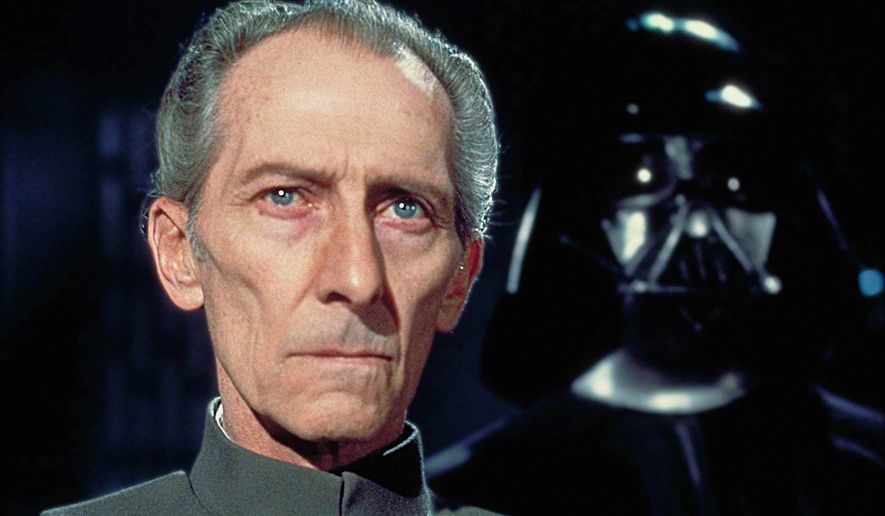ANALYSIS/OPINION:
(NOTE: This article contains minor spoilers about a character in “Rogue One,” but reveals nothing of the plot.)
It is not news that Grand Moff Tarkin and Peter Cushing, the actor who portrayed the Imperial stooge in 1977, are no longer with us, through means both Rebel Alliance-caused (in the former) and, through cancer and natural old age (the latter).
By now, with “Rogue One” raking in a half-billion and counting for Disney, it is likewise no longer secret that Tarkin has been resurrected for the new “Star Wars” standalone film. Fine, since “Rogue One” takes place immediately — and I do mean immediately — before “A New Hope.” But while it’s great to see the evil bureaucrat back for a curtain call on the Death Star, here’s where the fan service turns chillingly into the blood-curdling:
Through the magic of CGI, not only is Tarkin back, but Peter Cushing the actor is back as well, with Cushing’s face digitally superimposed over that of fellow British actor Guy Henry, who provides the voice and physical performance but hidden underneath a simulacrum of Cushing’s face created inside a computer.
I’ll be the one to say it: It’s effing weird!
Now Cushing, mostly known for his work in the Hammer horror films prior to being tapped by George Lucas for the original “Star Wars,” died in 1994, making it rather difficult for him to perform in a film 22 years after his passing. It’s just one half of the sin of “Rogue One,” which, because this is Disney-produced, somehow turns death into a negotiable state of being.
Mr. Henry looks enough like Cushing that it would have been well enough to cast him as Tarkin and be done with it. The first time he turns to camera, some Imperial lackey could spout off, “Hey, GM Tarkin, how’s about them rascally Rebels, yo?” and, through the magic of suspension of disbelief, we would soon enough forget that this is in fact a new actor inhabiting a beloved part nearly four decades after the fact.
The James Bond franchise has gotten away with this for a half-century. See also Maggie Gyllenhaal in “The Dark Knight,” Darren in “Bewitched” and just about every soap opera since time memorial putting a character through “plastic surgery” when contract renewals go bad.
That would have been the classy move for “Rogue One.” Alas, what we get is, basically, not a simulation, but an approximation of a simulation — a dead character portrayed by a living actor inhabiting not the character, but imitating the dead actor.
Creepy.
Over the weekend, my friend Philip and I discussed the phenomenon known as the “uncanny valley,” a philosophical axiom wherein that, at a certain point as something becomes more humanlike, our ability to empathize with a computer-generated character suddenly dips as as it becomes perhaps too lifelike. This is why we instinctively are drawn to adorable creatures like Pinocchio, WALL-E, Johnny 5, the Incredibles, the Simpsons, the Griffins, all of whom exhibit humanlike traits but are unmistakably simulations, but not say to video game avatars or to the CGI actors of the “Final Fantasy” films. (It’s also why we’re instinctively sketched out by those creepy Japanese sex dolls.)
The more real something fake becomes, the less we appear to like it.
This is also why, in “Rogue One,” our sympathies are most affected by the droid K-2SO, voiced by actor Alan Tudyk. K-2SO is unmistakably a computer-animated machine, but Mr. Tudyk’s vocal performance imbues K-2SO with humanity, making him, just like HAL-9000, more human than the humans.
I’m not an attorney — though I have seen almost every episode of “Perry Mason” ever — but I’d be willing to wager the contract Cushing signed in the mid-’70s included the old proviso that the producers of “Star Wars” could use his likeness as Grand Moff Tarkin forevermore “in mediums, whether now known or unknown.” When Cushing died in 1994, CGI was just coming into its own, and the sale of Lucasfilm to the Mouse House was two decades out. I suspect his estate had to sign off on his “resurrection” in “Rogue One,” making it all legal.
(And recall, a lookalike actor made a blink-and-you’ll-miss-it appearance as Tarkin in “Episode III.”)
But the question remains: Just because the producers of “Rogue One” can do this, should they? And how far will this go? (Minor spoiler alert coming now!) Princess Leia also makes a quick appearance at the end of “Rogue One,” but it too is a fake melding of Carrie Fisher’s 1977 face with another actress’ body.
So we can now likely expect Luke Skywalker to pop in to the standalone Han Solo adventure scheduled for 2018 (which we can only hope will be called “Han Goes Solo”), but it’ll be soap opera-era Mark Hamill versus the grizzled hermit from the end of “Force Awakens.”
With a film a year, this will be happening for the next few decades, so long as audiences continue showing up to eat it all up — and almost certainly long after Mr. Hamill, Miss Fisher and Harrison Ford have become one with the Force by departing this mortal coil.
Because in “Star Wars,” at least in the Disney version of it, death is no longer the end. Rather, the cast will be expected to perform long after their faces are frozen in rigor mortis.
To hell with retirement. Tarkin is just the beginning.
Eric Althoff is Entertainment Editor of The Washington Times.
• Eric Althoff can be reached at twt@washingtontimes.com.




Please read our comment policy before commenting.